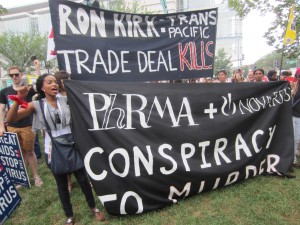Reported from Washington, D.C. for Cleveland.com (The Plain Dealer) with accompanying photo slideshow and video: http://www.cleveland.com/healthfit/index.ssf/2012/07/international_aids_conference_2.html
By Casey Capachi
WASHINGTON, D.C. — On Tuesday, protesters outside the Walter E. Washington Convention Center shouted “We can end AIDS!” while holding signs decrying big pharmaceutical companies and US trade policy. Inside the center, at the International AIDS conference, researchers and advocates discussed what it would take on a social and scientific level to end the epidemic globally and in the U.S.
The 19th International AIDS Conference started Sunday and continues until Friday. There are more than 23,000 medical professionals, advocates, policy makers, and people living with HIV/AIDS from more than 180 countries, making it the largest AIDS conference in the world.
“It was more than 30 years ago when the first HIV cases were identified in the United States,” said Dr. Howard Koh, U.S. Assistant Secretary for Health.
“I will never forget the patients we cared for and the way they suffered. Since then, more than 640,000 Americans lost their lives to AIDS. Today, an estimated 1.1 million people are living with HIV in the U.S. One in five is unaware of his or her infection.”

As part of President Barack Obama’s goal of an AIDS-free generation and the first-ever national HIV/AIDS Strategy, it was announced last week by U.S. Secretary of Health and Human Services Kathleen Sebelius that $80 million in new grant awards would go toward expanding care to an additional 14,000 low-income people living with HIV/AIDS. The money will be given to Ryan White community-based health clinics. Koh said that according to state administrators, this will result in an elimination of the Ryan White Aids Drugs Assistance Program (ADAP) waiting lists.
Outside, rain did not deter protesters from marching in the “We Can End AIDS” mobilization. The march started from five different locations and ended at Lafayette Square next to the White House.
Some participants wore Robin Hood costumes, advocating for a “Robin Hood tax” on wealthy Americans, and others held signs reading “Act up + Occupy.” About a dozen protesters were arrested for tying red ribbons laced with medication and money to White House gates, symbolizing the need for more funding for HIV/AIDS medication.
“I think the current mechanism for poverty protection globally is ridiculous” said Jorik Ooms, a human rights lawyer, who works in Antwerp, Belgium. Ooms, like many other protesters, left the conference to join the march.
“It doesn’t make any sense for people in rich countries but its deadly for people in poor countries because they can’t have access to the medications they need, and we urgently need to rethink that system. It’s a very poor system and it kills people,” Ooms said.
The U.S. remains the largest donor when it comes to global HIV/AIDS funding, accounting for more than half (59.2% in 2011) of disbursements by donor governments, according to a report by UNAIDS and the Henry J. Kaiser Family Foundation. The next biggest contributors are the U.K. (accounting for 12.6% of disbursements in 2011), France, Netherlands, Germany, and Denmark.
From 2009 to 2010, 23 donor governments reduced funding from $7.6 billion to $6.9 billion, but have since increased it back up to $7.6 billion in 2011 (just below the $7.7 billion they disbursed in 2009). Donor governments provide the majority of funding for hard-hit countries.
“The problem that we have run into, which is very disappointing to me and everybody who cares about the AIDS cause is that the rapid increase has now on balance stopped. You have some countries who are actually cutting,” said Bill Gates, co-chair of the Bill & Melinda Gates Foundation, in a press conference following his panel discussion on improving the efficiency and effectiveness in the HIV response.
“Because we don’t have a cure, as you put people on treatment that is a lifelong treatment, so all the new people you put on treatment just increased the number you need drugs for,” said Gates.
Talks surrounding funding and organization at a local level interested Jeffrey Mazo, a Cleveland native, as well. Mazo, 61, has been an advocate for HIV/AIDS education and prevention since finding out he was HIV-positive. Mazo said he hopes to learn about practices in other areas he can bring back to the AIDS service organizations (ASOs) he volunteers at.
Mazo said he is most concerned about reaching African-American men, the population at highest risk for contracting HIV. African-American men made up 44 percent of new HIV infections in the U.S. in 2009, according to a Kaiser Family Foundation report.
“Our agencies are still operating in a model that worked in the 1980s and 90s,” said Mazo, exploring the Global Village with fellow Cleveland delegates. “If we work together, we can change the tide in Cleveland.”
Follow Plain Dealer reporter Casey Capachi at the International AIDS Conference on Twitter: @caseycapachi